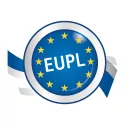
Under the title « Open Source Software Recht: Große FAQ mit vielen Praxistipps” (in German language) the German lawyer Niklas Plutte (Rechtsanwalt) summarises the main questions related to open source licensing.
In particular, the paper analyse how far open licences will produce a reciprocal (or copyleft) effect, meaning that in case or re-distribution of the program (as is, modified or in combination with other software) the copy, the modified or derivative work must be provided under the same licence and made available to the public in source code form, which could be shared and reused by anyone.
Three categories of reciprocal (or copyleft) licences are identified:
a. Licences with a strong copyleft effect, where any reuse of the covered code, even linked with other works or integrated in a much wider combination, could make the whole resulting combination a derivative of the covered code and therefore the whole combined distribution must also be covered by the strong copyleft licence. This has often been considered as a “viral effect”.
Examples: GNU General Public License (GPL and AGPL), Deutsche Freie Softwarelizenz (d-fsl).
b. Licences with a moderated (or weak) copyleft effect, which are especially convenient for tools or libraries, where the original code and its direct modification must stay covered by the original licence, but not the other software produced by the tool of combined with it. These combinations could be distributed under private (or proprietary) conditions, without disclosing and sharing any line of their source code.
Examples: GNU Lesser General Public License (LGPL), Zimbra Publice License (ZPL); Mozilla Public License (MPL).
c. „Interoperable“ copyleft-Licences, which is a new category applicable to the European Union Public Licence (EUPL) where the level of reciprocity is comparable to the one obtained from the GPL, but without “viral effect” and authorising the integration and distribution of the covered source code in a new (or other) combined derivative program, provide this derivative is distributed under the EUPL or under one of the compatible licences listed in the EUPL appendix (meaning the GPL-2.0, GPL-3.0, AGPL, MPL, EPL, OSL, LGPL, CeCILL etc.).
The Niklas Plutte FAQs paper is interesting as it analyses how far the EUPL is innovative and creates a new category of interoperable open source licences.
More information (in German): https://www.ra-plutte.de/open-source-software-recht-grosse-faq-tipps/
Referenced solution


